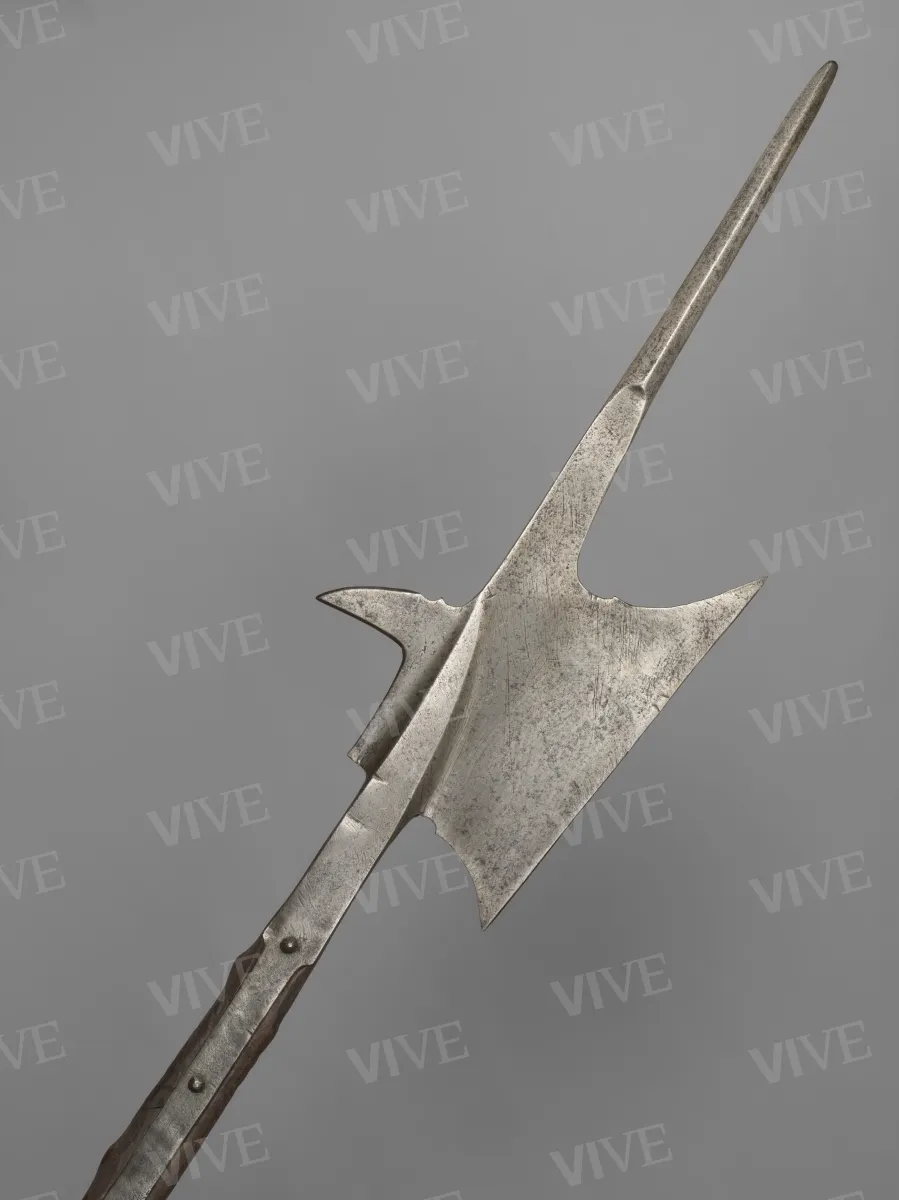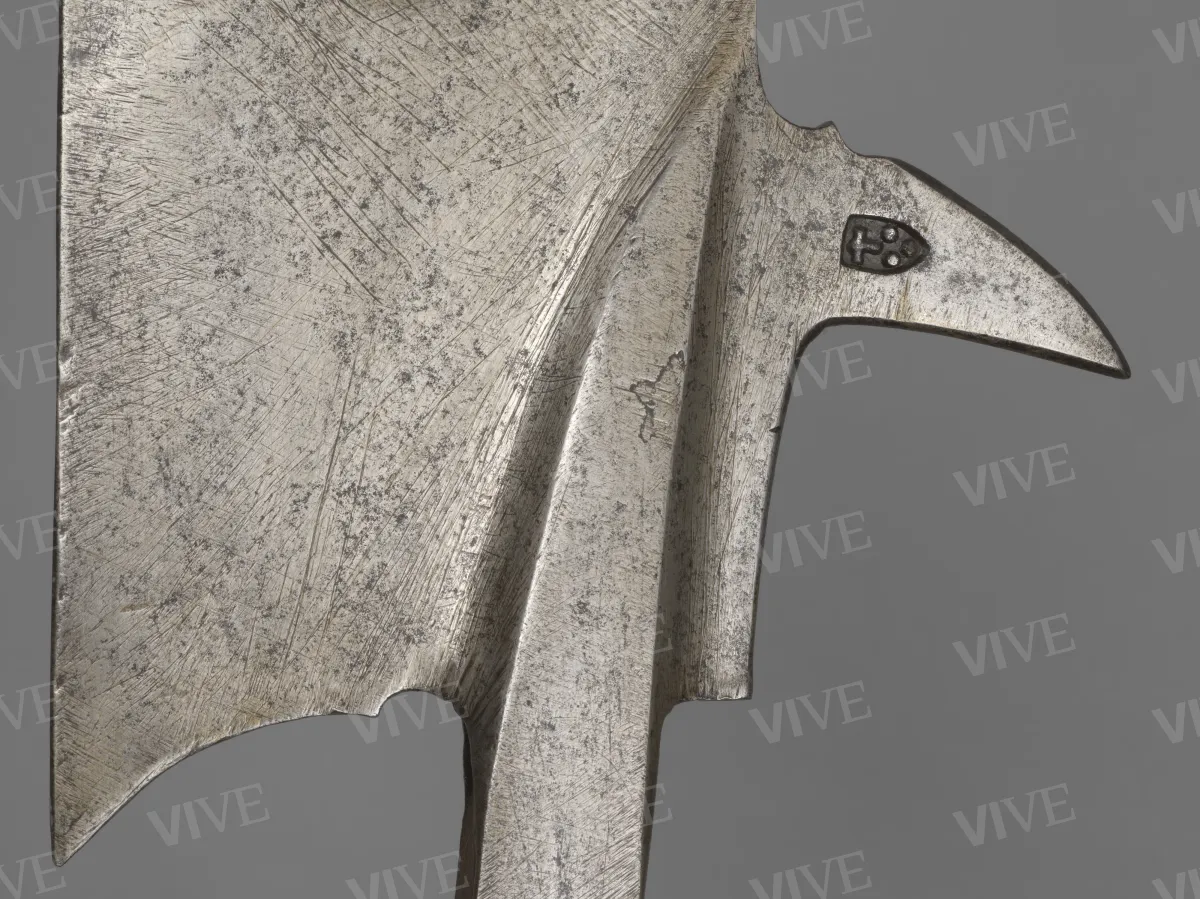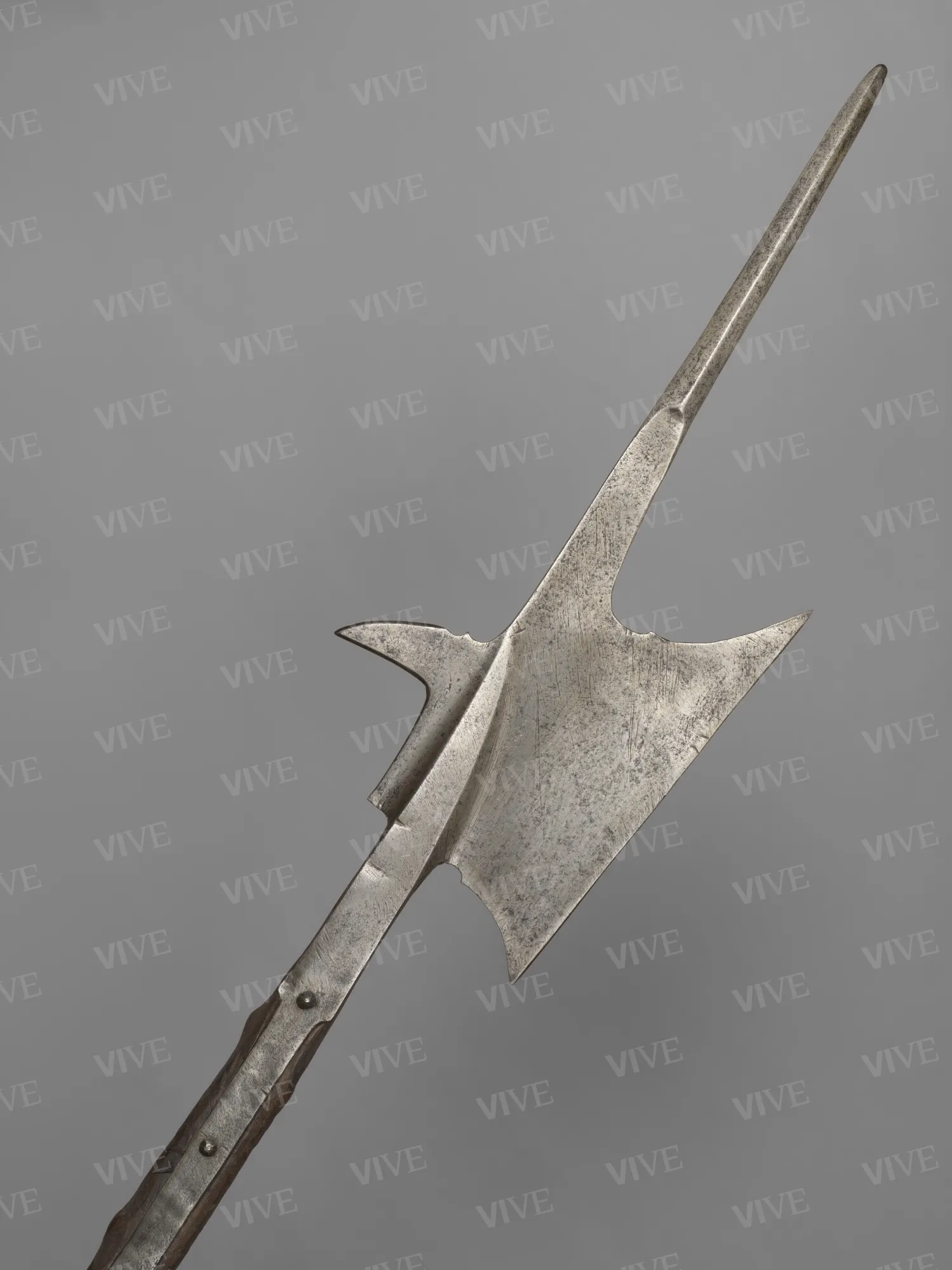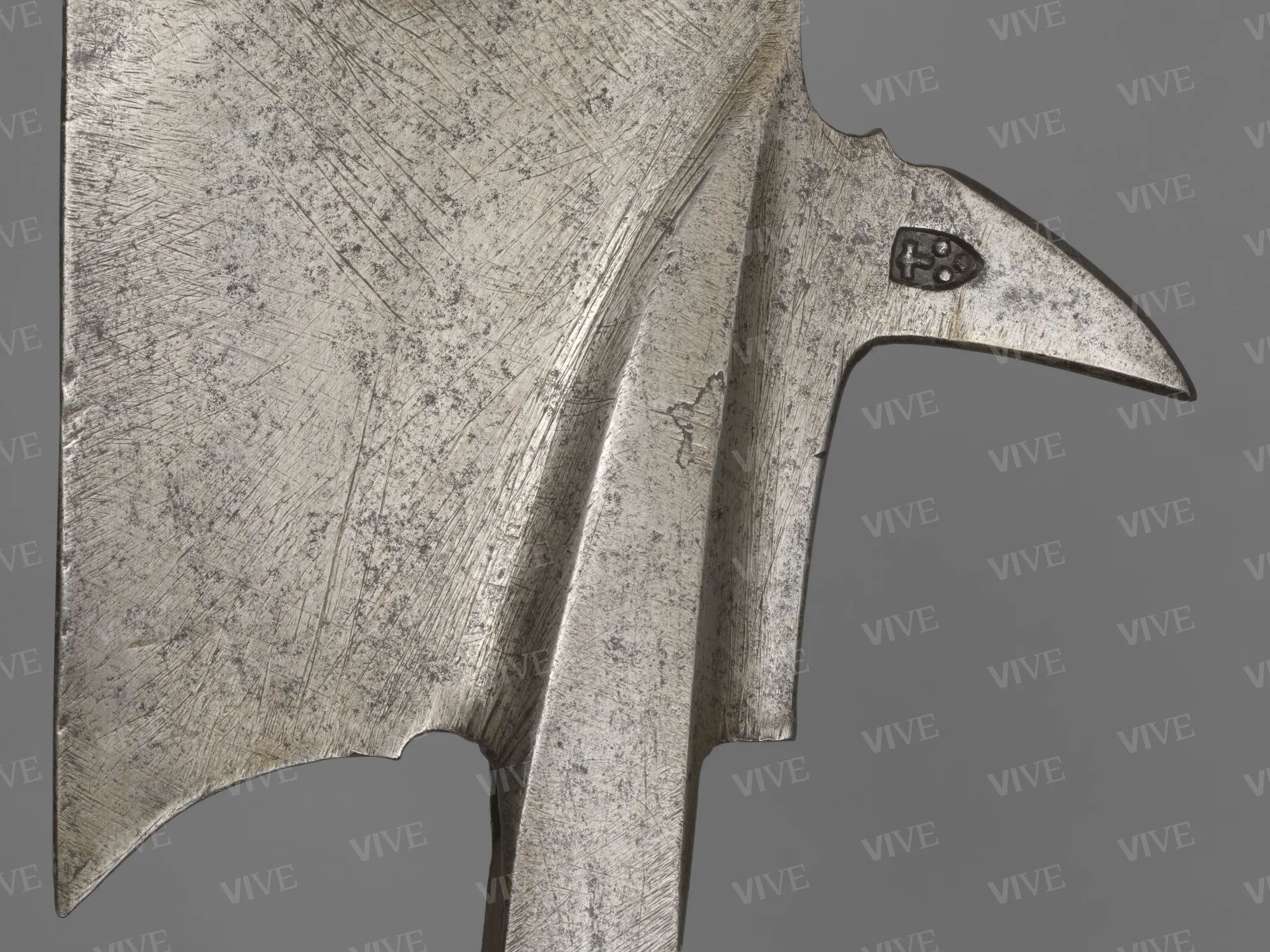Halberd
Swiss production 1480–1510
The halberd is characterized by a long wooden shaft with a metal blade, point, and beak, marked by a Swiss weapons maker from the late fifteenth to early sixteenth century. Having gained prominence in Europe since the fourteenth century, it became the infantry's favored bladed weapon owing to its versatility and combat effectiveness.
The halberd is characterized by a long wooden shaft with a metal blade, point, and beak, marked by a Swiss weapons maker from the late fifteenth to early sixteenth century. Having gained prominence in Europe since the fourteenth century, it became the infantry's favored bladed weapon owing to its versatility and combat effectiveness.
Details of work
Catalog entry
The halberd features a straight-edged blade with an upward-pointing segment, culminating in a square shape with a quadrangular cross-section. On the opposite side, it possesses a point resembling a hawk's beak, marked with the weapons maker's emblem (di Carpegna 1969, p. 60, n. 353; di Carpegna 1976, p. 60). This weapon is crafted from forged iron and affixed to a long wooden shaft using six nails. The metal surface displays evidence of wear, including scratches, impacts, and deep incisions.
The bladed weapon began to proliferate across Europe in the fourteenth century, with the German term “Helbarta” first appearing as early as 1315 (Geßler 1928, pp. 52–56). Its usage became more widespread in the fifteenth century, gaining popularity among Swiss mercenaries and Landsknechts during their incursions into Italy (Borgatti 1929). Utilized primarily by infantry, this weapon was highly effective in offensive engagements due to its long shaft, which allowed the wielder to maintain a safe distance from adversaries. Additionally, the weapon was equipped with three robust metal protrusions—a blade, a point, and a dorsal beak—that were designed for unseating opponents, harpooning, and striking blows (Waldman 2005, pp. 17–21).
This halberd features the hallmark of its maker on the dorsal beak. The shield with the letter “T” and three balls is not definitively attributed to a specific workshop; however, an identical mark can be observed on a halberd at the Metropolitan Museum in New York. Initially believed to be of German origin, this piece was later accurately identified as Swiss (inv. 14.25.80; Waldman 2005). During their period of widespread use, workshops in the Swiss cantons slightly varied the designs of these bladed weapons to facilitate troop identification on the battlefield (Scalini 2018, p. 125, n. IV.2).
Swiss weapons makers have been recognized for their expertise since the Middle Ages. During the Renaissance, transalpine workshops produced large quantities of armaments, which were brought to Italy by Swiss mercenaries and German soldiers. The design of this halberd, featuring a simple and solid construction with a straight-edged blade, is attributed to Swiss production in the area of Solothurn between the late fifteenth and early sixteenth centuries (Oakeshott 1980, pp. 47–48). The mark on the dorsal beak is also consistent with similar items from that period.
The weapon is part of the Prince Ladislao Odescalchi (1846–1922) collection, which was acquired by the Italian State in 1959 and subsequently stored at Palazzo Venezia in 1969. This extensive collection was not a family armory; rather, it was assembled through targeted acquisitions from both national markets, such as Florence and Rome, and international markets, including Paris and London, starting in the late nineteenth century. These purchases reflect Odescalchi’s personal preferences (Barberini 2007).
Similar halberds are included in the collection of Carl Otto Kretzschmar von Kienbusch, currently housed at the Philadelphia Museum of Art. Kretzschmar was an acquaintance of Odescalchi and his competitor in the antique market (inv. 1977–167–323 and 1977–167–322).
Giulia Zaccariotto
Entry published on 27 March 2025
State of conservation
Fair.
Coats of arms, emblems, and marks
On the dorsal beak, the weapons maker’s mark is in the form of a shield with a letter “T” and three balls.
Provenance
Rome, Collezione Ladislao Odescalchi (Odescalchi, n. 469);
acquired by Italian State, 1959;
Rome, Museo Nazionale di Palazzo Venezia, 1969.
Exhibition history
Rome, Museo Nazionale di Palazzo Venezia, Antiche armi dal sec. IX al XVIII. Già Collezione Odescalchi, maggio-luglio 1969;
Rome, Museo Nazionale di Castel Sant’Angelo; Roma, Museo Nazionale del Palazzo di Venezia, Armi e potere nell’Europa del Rinascimento, 26 luglio-11 novembre 2018.
References
Geßler Eduard Achilles, Führer durch die Waffensammlung. SchweitzerischesLandesmuseum, Zürich 1928;
Borgatti Mariano, Alabarda, ad vocem, in Enciclopedia Italiana Treccani, Roma 1929;
di Carpegna Nolfo (a cura di), Antiche armi dal sec. IX al XVIII. Già Collezione Odescalchi, catalogo della mostra (Roma, Museo Nazionale di Palazzo Venezia, maggio-luglio 1969), con schede a firma del curatore, Roma 1969, p. 60, n. 353;
di Carpegna Nolfo, Le armi Odescalchi, Roma 1976;
Waldman John, Hafted Weapons in Medieval and Renaissance Europe: The Evolution of European Staff Weapons between 1200 and 1650, Leiden 2005;
Barberini Maria Giulia, La collezione Odescalchi di armi antiche: storia della raccolta del principe Ladislao, in «Bollettino d’arte», s. VI, XCI, 2006 (2007), 137/138, pp. 101-114;
Fossà Bianca, Studio conservativo delle armi e armature Odescalchi. Nuove metodologie per la schedatura di una collezione, in «Bollettino d’arte», s. VI, XCI, 2006 (2007), 137/138, pp. 115-142;
Oakeshott Ewart, European Weapons and Armour. From the Renaissance to the Industrial Revolution, Woodbridge 2012 (I ed. 1980);
Scalini Mario (a cura di), Armi e potere nell’Europa del Rinascimento, catalogo della mostra (Roma, Museo Nazionale di Castel Sant’Angelo; Roma, Museo Nazionale del Palazzo Venezia, 26 luglio-11 novembre 2018), con schede a firma del curatore, Cinisello Balsamo 2018, p. 125, n. IV.2. [con indicazione di inventario Odescalchi e PV errate].














